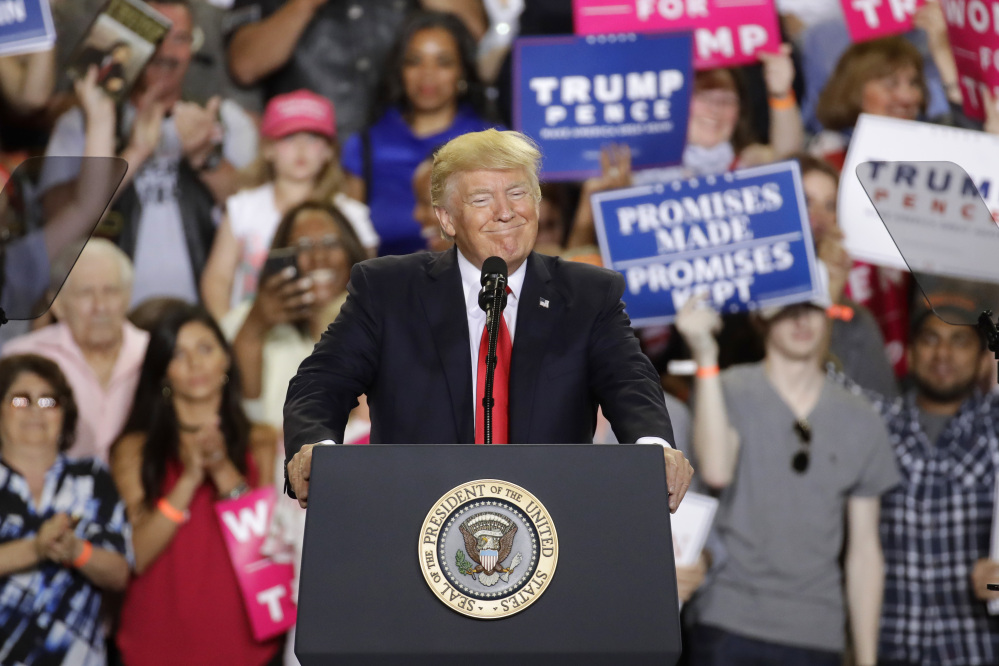WASHINGTON — President Trump on Tuesday called for a government shutdown later this year and suggested the Senate might need to prohibit future filibusters, threatening to fracture Washington’s basic underpinnings to make progress on his legislative goals.
His latest outbursts – no sitting president has called for the government to be shut down like this – could cast a shadow over how Congress approaches numerous bills this year. Trump wants Congress to overhaul the tax code, approve a $1 trillion infrastructure package and raise or suspend the debt ceiling before the government begins falling behind on its obligations.
He has made little legislative progress in any of these areas, and he is on the verge of being dealt another stinging defeat as House Republicans splinter on a health-care bill for the second time in recent weeks. Trump’s new threats suggest he will jettison attempts at compromise and instead use the bombastic partisan warfare he employed during his campaign.
The threats come after White House officials said they were furious at what they viewed as gloating by Democrats over the terms of a short-term spending bill that funds government operations through Sept. 30. In morning Twitter posts, Trump said he had to make concessions because Senate rules require 60 votes to pass legislation and Republicans control only 52 seats in the 100-seat chamber.
He wrote that Republicans needed to pick up more seats in the 2018 midterm elections or consider changing filibuster rules so that the Senate’s minority party cannot block bills.
“Our country needs a good ‘shutdown’ in September to fix mess!” he wrote.
Trump could easily trigger a partial government shutdown in October, by directing Republicans not to negotiate with Democrats or by refusing to sign a spending bill that Congress sends him for approval.
White House Office of Management and Budget Director Mick Mulvaney said Tuesday that Congress needs to return to the practice of passing one-year appropriations bills and sending them to the White House for approval, not continuing the recent practice of lurching from one stopgap spending bill to the next.
“This is a change-agent president, and he’s going to change Washington, D.C.,” Mulvaney said. “And if it takes a shutdown, that’s what it’s going to take.”
Mulvaney added, though, that a shutdown was not “desirable,” seeming to break with the president.
Mulvaney plans to release a full-scale budget in mid-May that is supposed to help lawmakers craft their 2018 budgets. He said he wants work on those spending bills to begin immediately.
Timothy Naftali, a presidential historian at New York University, said Trump’s threat of a shutdown was “totally, totally, totally” unprecedented.
He said the threat, coupled with talk of changing filibuster rules, was typical of Trump’s approach.
“Really what he’s talking about is destroying congressional procedures to get his way,” Naftali said. “When he’s losing, he likes to flip the game board.”
The White House did win numerous concessions during the recent negotiations with Congress over the stopgap spending bill. Democrats agreed, for example, to $1.5 billion in new money for border security and roughly $21 billion in new defense spending, two of Trump’s top priorities. But, Mulvaney said, Democrats tried to “spike the football” because they blocked new funding for a wall along the Mexico border.
Despite the White House’s frustration, Trump’s suggestion that spending bills should be able to pass with a simple majority was quickly dismissed by numerous top Republicans, including Senate Majority Leader Mitch McConnell, R-Ky.
Copy the Story LinkSend questions/comments to the editors.



Success. Please wait for the page to reload. If the page does not reload within 5 seconds, please refresh the page.
Enter your email and password to access comments.
Hi, to comment on stories you must . This profile is in addition to your subscription and website login.
Already have a commenting profile? .
Invalid username/password.
Please check your email to confirm and complete your registration.
Only subscribers are eligible to post comments. Please subscribe or login first for digital access. Here’s why.
Use the form below to reset your password. When you've submitted your account email, we will send an email with a reset code.